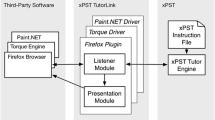Abstract
The Generic Tutoring Environment (GTE) is an authoring environment for the development of courseware. Claims with regard to GTE's epistemological foundations are analyzed and explored. GTE's assumptions are thereby shown to reveal a somewhat reductionist bias, which is to say that GTE has placed emphasis on computational approaches to instructional modeling. Nevertheless, pragmatic concerns with regard to GTE's utility and effectiveness are of interest to the developers and to other researchers in the fields of courseware design and instructional modeling. In general, GTE is seen to be both ambitious and powerful. While GTE does not truly provide an epistemology of instructional design, it does provide a powerful framework within which effective tutors can be efficiently generated.
Similar content being viewed by others
References
Ericsson, K.A. & Smith, J., eds. (1991). Toward a General Theory of Expertise: Prospects and Limits. New York: Cambridge University Press.
Gagné, R.M. (1985). Conditions of Learning (4th Ed.).New York: Holt, Rinehart, and Winston.
Gagné, R.M. (1995). Learning processes and instruction. Training Research Journal 1: 17–28.
Grimstad Group (1995). Applying system dynamics to courseware development. Computers in Human Behavior 11(2): 325–339. [The Grimstad Group consists of P.I. Davidsen, J.J. Gonzalez, D.J. Muraida, J.M. Spector & R.D. Tennyson.]
Hannafin, M.J., Hall, C., Land, S. & Hill, J. (1994). Larning in open-ended environments: Assumptions, methods, and implications. Educational Technology 34(8): 48–55.
Harward, V.J. & Lerman, S.R. (1994). The Athena Muse???Multimedia Environment. Internal Technical Paper. Cambridge, MA: MIT Center for Educational Computing Intitiatives.
Kozma, R.B. (1994). Will media influence learning? Reframing the debate. Instructional Science 42(2): 7–19.
Krammer, H.P.M., Bosch, J. & Dijkstra, S. (1995). Scalability in instructional method specification: An experiment-directed approach, in R.D. Tennyson & A. Barron, eds., Automating Instructional Design: Computer-Based Development and Delivery Tools. Berlin: Springer-Verlag.
Merrill, M.D. (1993). An integrated model for automating instructional design and delivery, in J.M. Spector, M.C. Polson & D.J. Muraida, eds., Automating Instructional Design: Concepts and Issues. Englewood Cliffs, NJ: Educational Technology.
Muraida, D.J., Spector, J.M., O'Neil, H.F. & Marlino, M.R. (1993). Evaluation, in J.M. Spector, M.C. Polson, & D.J. Muraida, eds., Automating Instructional Design: Concepts and Issues. Englewood Cliffs, NJ: Educational Technology.
Paquette, G., Aubin, C. & Crevier, F. (1994). An intelligent support system for course design. Educational Technology 34(9): 50–57.
Perez, R.S. & Neiderman, E.C. (1992). Modeling the expert training developer, in R.J. Seidel & P. Chatelier, eds., Advanced Training Technologies Applied to Training Design. New York: Plenum Press.
Reigeluth, C.M., ed. (1983). Instructional-Design Theories and Models: An Overview of Their Current Status. Hillsdale, NJ: Erlbaum.
Resnick, L.B., ed. (1989). Knowing, Learning, and Instruction. Hillsdale, NJ: Lawrence Erlbaum.
Rowland, G. (1992). What do instructional designers actually do? An initial investigation of expert practice. Performance Improvement Quarterly 5(2): 65–86.
Simon, H.A. (1969). The Sciences of the Artificial. Cambridge, MA: MIT Press.
Spector, J.M. (1994). Integrating instructional science, learning theory and technology, in R.D. Tennyson, ed., Automating Instructional Design, Development, and Delivery. Berlin: Springer-Verlag.
Spector, J.M., Arnold, E.M. & Wilson A.S. (1996). A Turing test for automatically generated instruction. Journal of Structural Learning 12(4): 301–313.
Tennyson, R.D. (1994). Knowledge base for automated instructional system development, in R.D. Tennyson, ed., Automating Instructional Design, Development, and Delivery. Berlin: SpringerVerlag.
Van Marcke, K. (1992). A generic task model for instruction, in S. Dijkstra, ed., Instructional Models in Computer-Based Learning Environments (NATO ASI Series, Vol. F104.) Berlin: Spinger-Verlag.
Van Marcke, K. (1996). GTE: An epistemological approach to instructional modelling. Instructional Science.
Author information
Authors and Affiliations
Rights and permissions
About this article
Cite this article
Spector, J.M. The role of epistemology in instructional design. Instructional Science 26, 193–203 (1998). https://doi.org/10.1023/A:1003023701635
Issue Date:
DOI: https://doi.org/10.1023/A:1003023701635




